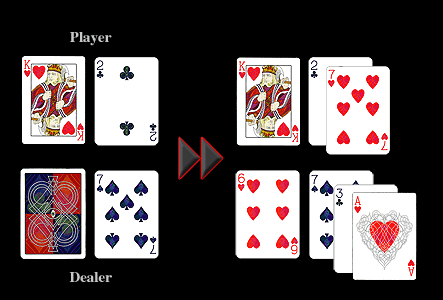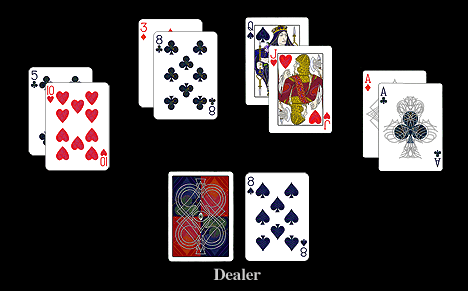
|
| « History of Playing Cards | Early Standards | Gallery of Playing Cards | Card Games Rules | CONTACT |
Basic Strategy
« « BlackJackBasic Strategy is the most basic system that all Blackjack players must master in order to become a successful player. It provides the Player with the optimal way to play based on the Player’s Total verses the Dealer’s Upcard. The system has been developed over several years of research and computer simulation. The result is a true Perfect or Correct Strategy, a mathematical imperative of best choices over time.
In Basic Strategy all we are learning to do is make the best decisions based on the cards we have and what the Dealer is showing. The Basic Strategy is based on the rules of Classic Twenty One, or Classic Blackjack, as detailed by NZonlinecasinos.kiwi. There are many other variations of blackjack, especially at online casinos, so the strategy would need to be adapted if playing another type. Other online blackjack games can get quite complex, such as Multi Hand Atlantic City Blackjack Gold, which the experts at CasinoCanuck.ca have done a great job of outlining here.
We know that the Dealer always Draws on 16 and Stands on 17. So it should be a safe bet to follow that strategy ourselves. In a sense, this is exactly what we do in Basic Strategy. However, if the Dealer is only showing a “6” or less, we don’t have to bother reaching 17 or more because the Dealer is more likely to Bust than to stand. In this way we make decisions that have been shown to benefit the Player most of the time.
In order to know the Basic Strategy there are three things you must learn:
- Simple Strategy – 7 Rules for Social Play
- When to Double Down
- When to Split Pairs
The Simple Strategy - Seven Rules for Social Play
In order to learn Basic Strategy thoroughly, and become fluent in play, the best thing to do is learn the Simple Strategy first. These 7 rules are easy to master and you will apply them in almost 90% or your play. In other words, this is the mainstay of Basic Strategy. The rules for Doubling Down and Splitting Pairs are added to this strategy to extend the Player’s advantage slightly more but here is the core.
Below is a table that shows 7 simple rules based on the “Player’s Total” verses the “Dealer’s Upcard”. You can also download a one page PDF to use as a practice guide. In order to learn the Basic Strategy it is recommended that you practice by dealing yourself some cards, and making the decisions over and over again.
Simple Strategy; Seven Rules to help you Lose Less |
||
| Player Does | Verses | Dealer's Upcard |
| Stand on 13 | V's | 2 or 3 |
| Stand on 12 | V's | 4, 5 or 6 |
| Stand on 17 | V's | 7 or more |
| Double Down on 11 verses Dealer's 10 or less | ||
| Double Down on 10 verses Dealer's 9 or less | ||
| Always Split 8,8's | ||
| Always Split A,A's | ||
Dealer's Upcard 7 or Less
When the Dealer is showing a 6 or less, he has a better than even chance of busting. So, the Player can pretty much relax and leave the Dealer to self-destruct. The only thing to remember is that if that upcard is a 2 or a 3, we stand on 13, not 12.
Stand on 13 verses Dealers 2 or 3. Stand on 12 verses Dealer’s 4, 5 or 6.
Double Down
‘Double Down” is when the Player double’s his bet on the first two cards, and receives just one more card in exchange. For example, if the Player’s first two cards are 8 and 3, he has a Total of 11. If he Hits, and he will, he has a better chance of hitting twenty-one than any other Total, and a better than even chance of a Total greater than 17. If he doubles his bet, he doubles his most likely rewards. But remember, if that card is a 5 or a 6 for example, the Player cannot hit again. When you Double-Down, you only receive one additional card. In addition to doubling down there are other basic strategies that can be used in Blackjack.
Always Split 8's, Always Split Aces
With two eights and you’ve got a Total of 16. No one wants a total of 16. Split and Hit, you’ve got a better than even chance of arriving at a Total of 17 or more. Even when the Dealer is showing a “6” or less and 16 would be a comfortable Stand, split the pair and double your rewards for Dealer’s better than even chance of Busting. So, all the odds say “Split”.
Splitting Aces would seem good sense to anyone, and it is. When you split Aces you only receive one additional card for each Ace. You can’t Hit again. If either of those cards is a “10” it’s not a Blackjack and only pays the usual 1 to 1, not 1½ to 1 . A Blackjack only applies the Player’s first two cards. That’s why it’s also called a “natural”. You don’t get it for extras.
Mastering Basic Strategy
Basic Strategy is not something that you can learn by walking into a casino and trying it out. You need to practice. It’s got to be second nature. And the best way to practice is to take a deck of cards and deal out a hand of BlackJack in the following manner.

As you go through the deck, make all the decisions, to Hit, Stand, Double Down, or Split. Play the Dealer’s draw on 16 and Stand on 17.
You can also deal out practice plays like this. You will go through the cards faster, so you can always combine two or more decks.
 DOWNLOAD PDF: BlackJack - Basic Strategy
DOWNLOAD PDF: BlackJack - Basic Strategy
Perfect Blackjack Strategy
Once you have mastered these simple rules , you will have in place the basis of Basic Strategy. In order to master the complete strategy, there are two more areas of refinement to attend to. These are the rules for 'doubling down' and the rules for 'splitting pairs'. These do not alter the rules you have learnt above. They build and extend on them.
Rules for Doubling Down |
||
| Double Down On | Verses | Dealer's Upcard |
| 11 | V's | 2-10 |
| 10 | V's | 2-9 |
| 9 | V's | 3-6 |
| A6-A7 | V's | 3-6 |
| A4-A5 | V's | 4-6 |
| A2-A3 | V's | 5-6 |
Rules for Splitting Pairs |
||
| Split | Verses | Dealer's Upcard |
| A,A | V's | Any Card |
| 9,9 | V's | 2-9 but not 7 |
| 8,8 | V's | Any Card |
| 7,7 | V's | 2-7 |
| 6,6 | V's | 2-6 |
| 4,4 | V's | 5-6 |
| 3,3 | V's | 2-7 |
| 2,2 | V's | 2-7 |
Further Reading:
Ken Uston's Blackjack World - The Official Ken Uston Web Site
WikiPedia - Ken Uston
BlackJack |
||||||||
| BlackJack | ||||||||
| Basic Strategy | ||||||||
| Card Counting | ||||||||
| Strategy Tables | ||||||||
| History of BlackJack | ||||||||
| Legends of BlackJack | ||||||||
| Ken Uston | ||||||||
| ||||||||
| ||||||||
| ||||||||
|
||||||||
|